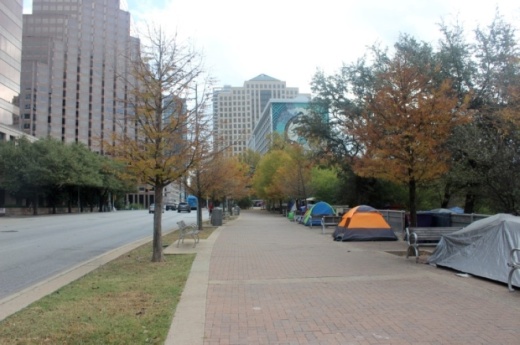The apparent warming up to sanctioned homeless encampments—an idea rejected by city staff in 2019—comes as City Council faces mounting pressure from residents and the governor to address the growing visibility of homeless camps throughout the city. Calls to reinstate the more restrictive version of its public camping ban that City Council repealed in June 2019 have intensified.
Sanctioned homeless encampments are plots of land designated by the government as a safe and encouraged place to camp, as opposed to encampments that have organically cropped up on public land, such as along East Cesar Chavez Street or East Riverside Drive. Gov. Greg Abbott set up a sanctioned encampment in Southeast Austin in November 2019 to initially mixed reviews; however, people in the homeless community, service providers and city leaders have since said the camp has had some moderate success but maintained it is not, in and of itself, a solution to homelessness.
Nothing is off the table
Answering a question posed by District 10 City Council Member Alison Alter during City Council’s work session, the city’s new homelessness strategy officer, Dianna Gray, told elected leaders that city-designated encampments were a possible tool as the city searches for solutions.
“I think it’s on the table. ... We can look all those options and come back to you with, at least initially, what we believe the pros and cons of those are,” Gray said.
She also clarified that the sanctioned encampments could only work if the long-term intent of the city is to provide housing.
Council Members Alter, Kathie Tovo and Ann Kitchen raised concerns during the work session about a growing number of encampments along the city’s hike and bike trails. Camping in public parkland is still prohibited under the city’s more relaxed camping ordinance. Gray said the city was not currently clearing encampments due to Centers for Disease Control and Prevention pandemic guidelines, which say doing so could increase the spread of the coronavirus.
“I think we might all agree that where some of that camping is happening right now is not where we would designate it if we had to designate it, but it is, [by] default, a designated camping area, and there has to be a better approach,” Alter said.
This is not the first time City Council has brought up sanctioned encampments as a potential tool. In the heated aftermath of the June 2019 decision to repeal the camping ban, some City Council members floated the proposal; however, Assistant City Manager Rodney Gonzalez, who was then overseeing the homelessness response, rejected the idea in a memo to City Council, saying instead the city would focus its resources on growing its shelter capacity.
During the Jan. 25 work session, Adler said the city’s efforts to increase its shelter and housing capacity have fallen short, and more immediate answers are now needed.
“I think it's significant that when we first looked at this we had pretty much taken off the table designated camping areas because that's not something that is generally desirable,” Adler said. “At the same time, we have an emergency situation and a need for rapid housing that may very well trump that.”
Growing pressure
Adler said he did not support efforts to reinstate the city’s more restrictive camping ordinance, as supported by the group Save Austin Now. The group, led by Travis County GOP Chair Matt Mackowiak, submitted a petition Jan. 19 with an alleged 27,000 signatures in support of putting the camping ban question on the May 1 ballot. The city clerk is still counting and validating the signatures.
Abbott said he also supports more restrictive camping. On Jan. 21, the Texas governor said he expects to “announce a statewide plan to address homelessness that will include a ban on camping as well as other ideas.”
Thomas Woodward, a formerly homeless Austin resident who worked for the street community-run Challenger Newspaper but is now housed, called the camping rules a “very complex situation.”
“It’s an unfortunate situation when we have bureaucrats in office who are disconnected and have no idea what these people have been through,” Woodward said. “A lot of people who are camping out have been through homeless services in Austin ... and got nothing from it. There is a lot of distrust between these people and the city. They just really want to be left alone.”
Woodward said he does not agree with allowing camps along places such as Cesar Chavez, the hike and bike trails, or parks and emphasized the need for the city and community to rebuild trust with the homeless population.
“They just need to house these people,” Woodward said. “They have the time and money.”
Matt Mollica, the executive director of the local Ending Community Homelessness Coalition, said sanctioned encampments could work if done empathetically.
“It’s not a solution for ending homelessness; it’s a step to provide a more dignified place for people to be in if it gives people access to noncongregate housing, access to food and hygiene,” Mollica said. “It’s not a replacement for recriminalizing homelessness.”
Mollica said Abbott’s sanctioned encampment in Southeast Austin works “to the extent that it is” because people have a choice whether they are there and people think it is a better solution than what they had previously.
Mollica said he supports providing more options while not taking away any rights. However, he said the city needs to build a more strategic approach, listen to people experiencing homelessness and provide better options to serve them.





